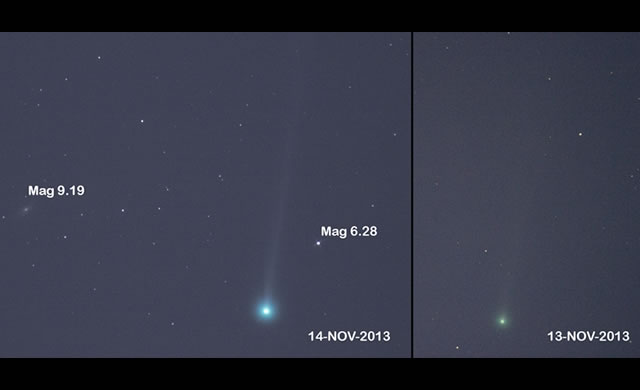
Taken by Charles Coburn on November 14, 2013 @ Rescue, CA USA
Un improvviso scoppio di luminosità sta interessando la Cometa ISON nel suo avvicinamento verso il Sole che la ha rapidamente portata alla soglia di visibilità ad occhio nudo. “Ho osservato e ripreso la Cometa ISON ogni mattina”, riferisce l’astrofilo Charles Coburn di Rescue, in California. “Oggi, con mia grande sorpresa, ho potuto vedere questa schermata di anteprima dal vivo. ” Queste due immagini mostrano la cometa in giorni consecutivi, come è apparsa nelle foto di Coburn utilizzando la stessa macchina fotografica e impostazioni del telescopio. Rapporti come questo di Coburn stanno arrivando da tutto il mondo.
A quanto pare, durante le prime ore del 14 novembre la Cometa ISON è salita di luminosità di un fattore, di circa 6. In termini di grandezze astronomiche , è saltato da 8 a 6. Se continua così, ISON potrebbe essere un oggetto visibile a occhio nudo, se pur ancora debole, per la fine della settimana. L’improvviso incremento di luminosità potrebbe essere causato da un’apertura di ghiaccio nel nucleo della cometa. La rapida vaporizzazione del ghiaccio grazie al calore solare è un modo sicuro per aumentare la visibilità di una cometa. Ma, esattamente come per la NASA Comet ISON Observing Campaign, “non ne abbiamo idea”. Il nucleo della cometa è nascosto alla vista da una nube di gas verde e nebbiosa, così gli eventi al suo interno rimangono un mistero. “Ho un forte sospetto che questo sia un caso simile a quello della cometa LINEAR ( C/1999 S4 )”, dice Mark Kidger del Centro astronomico spaziale europeo dell’ESA a Madrid. Nel 2000 , Kidger e altri astronomi hanno infatti monitorato la Cometa LINEAR osservando come si disintegrò in rotta verso il sole. ” L’improvvisa apparizione di gas nella coda di ISON, la crescente confusione del suo coma, e ora questo improvviso scoppio di luminosità, hanno fatto ricordare C/1999 S4 poco prima che si dissolvesse. “Per ribadire : Nessuno sa che cosa sta accadendo alla Cometa ISON . Questo potrebbe essere un segnale di agonia per la cometa, o solo il primo di molti eventi che porteranno ad una brillantezza progressiva, tipico nell’esperienza che compete una cometa che si tuffa verso il sole, il incontro ravvicinato è previsto per Giorno del Ringraziamento (28 novembre). Il monitoraggio continuo è fortemente incoraggiato. La Cometa ISON sorge a est poco prima del sole. Date di particolare interesse: il 17 e 18 novembre, quando la cometa passerà la luminosa stella Spica, rendendo ISON molto più facile da trovare nel cielo.
A sudden outburst of brightness from sundiving Comet ISON has catapulted it to the threshold of naked-eye visibility. “I’ve been imaging Comet ISON every morning,” reports amateur astronomer Charles Coburn. of Rescue, CA. “Today, to my surprise, I could see it on my DSLR live preview screen.” These two images show the comet on consecutive days as photographed by Coburn using the same camera and telescope settings. Reports like Coburn’s are coming in from around the world.
Apparently, during the early hours of Nov. 14th Comet ISON surged in brightness by a factor of approximately 6. In terms of astronomical magnitudes, it jumped from +8 to +6. If the trend continues, it could be a faint but easy naked-eye object by the end of the week. The sudden uptick in brightness could be caused by a fresh vein of ice opening up in the comet’s nucleus. Rapid vaporization of ice by solar heat is a sure-fire way to boost a comet’s visibility. But, as NASA’s Comet ISON Observing Campaign states, “we have no idea.” The comet’s nucleus is hidden from view by a hazy green atmosphere, so events in the interior remain a mystery. “I have a strong suspicion that this is Comet LINEAR (C/1999 S4) all over again,” says Mark Kidger of the ESA’s European Space Astronomy Centre in Madrid. In the year 2000, Kidger other astronomers monitored Comet LINEAR as it disintegrated en route to the sun. “The sudden appearance of ISON’s gas tail (discussed further below), the increasing fuzziness of its coma, and now this sudden outburst all remind me of C/1999 S4 just before it broke apart.” To reiterate: No one knows what is happening to Comet ISON. This could be the comet’s death throes–or just the first of many brightening events the comet experiences as it plunges toward the sun for a close encounter on Thanksgiving Day (Nov. 28th). Monitoring is encouraged. Comet ISON rises in the east just before the sun. Amateur astronomers, if you have a GOTO telescope, enter these coordinates. Dates of special interest include Nov. 17th and 18th when the comet will pass the bright star Spica, making ISON extra-easy to find.
Source/Continue reading → SpaceWeather.com





















